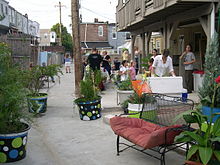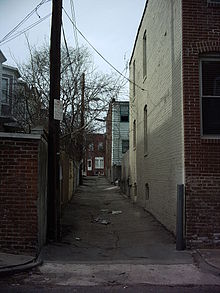- Community Greens
-
Community Greens
Community Greens, sometimes referred to as backyard commons, urban commons, or pocket neighborhoods, are shared open green spaces on the inside of city blocks, created either when residents merge backyard space or reclaim underutilized urban land such as vacant lots and alleyways. These shared spaces are communally used and managed only by the residents whose homes abut them. They are not a public park, a private backyard, or a community garden; however, they can function as all three. Communities nationwide are taking down their backyard fences; backyard commons already exist in numerous cities including Boston, Sacramento, Baltimore, New York, and San Francisco[1].
Community Greens are multi-functional spaces for gardening, recreation, and leisure which provide social, economic, and environmental benefits to urban residents. Communities that create backyard commons have increased interaction with neighbors throughout the planning and implementation process, which results in a stronger overall sense of community. Other social benefits include decreased crime from having more eyes on the street and having safe places for children to play and adults to relax. Community Greens, like other types of urban green spaces, significantly improve the ecological functioning of urban habitats. Vegetation and permeable pavement slows stormwater runoff and allows for groundwater recharge. This in turn reduces pollutant loads being carried to nearby waterbodies during storm events. Urban environments are often significantly warmer than outlying suburbs, mostly due to the prevalence of low-albedo concrete surfaces. City trees mitigate this heat island effect and cool the urban microclimate through shading and evapotranspiration[2]. When neighbors take down their fences, backyards are transformed from fragmented habitats to connected corridors for urban wildlife. City dwellers recognize value in green space, often simply from an aesthetic standpoint, and this is reflected through increased property values [3].
Mission
The mission of Community Greens is to catalyze the development of shared green spaces inside residential neighborhoods in cities across the United States. We call these green spaces community greens. We believe that the Community Greens approach presents the best opportunity to add usable green space to our cities by converting underutilized backyards and dysfunctional alleys into functional and beautiful shared green spaces that are owned, managed, and enjoyed by the people who live around them.
History
- Founded as an offshoot of Ashoka, by Ashoka founder Bill Drayton in 2001.
- Spearheaded a state wide legislature in Maryland, which changed the City Charter which allows the city to lease and gate alleys to homeowners.
- Started the Alley Gating and Alley Greening pilot project in Baltimore in 2006.
- Local ordinance passed in the City of Baltimore in 2007.
- As of 2009, there are 3 completely gated and greened alleys in Baltimore and over 70 applications from interested neighborhoods.
Baltimore: The Pilot Project
In 2002, a group of residents from the Patterson Park neighborhood approached the Patterson Park Community Development Corporation (CDC) looking for a way to improve the dirty, crime-ridden alley that ran behind their homes. Simulataneously, Community Greens also approached the Patterson Park CDC looking for an alley they could use as a pilot project in Baltimore, and these two groups were put into contact. The Luzerne-Glover block was granted a temporary permit from the city to gate their alleyway, despite the fact that it was not yet legal to gate a right-of-way. Community Greens, the Patterson Park CDC, the Patterson Park Neighborhood Association and the Luzurne‐Glover block group turned to University of Maryland law professor Barbara Bezdek, who enlisted the help of her law students, who researched existing laws and current uses of Baltimore alleyways.
Looking for a permanent solution, these groups aligned themselves with the Mayor's Department of Neighborhoods and took their case to Annapolis. Maryland Delegate Peter A. Hammen sponsored House Bill 1533 to amend the Baltimore City Charter, allowing the City to close alleyways and lease them to interested parties. The Luzerne-Glover group testified before the Environmental Committee of the state legislature and House Bill 1533 passed in 2004. Community Greens then worked with law firm Hogan & Hartson, in collaboration with Barbara Bezdek, to draft a city alley gating and leasing ordinance, which was then submitted to the City of Baltimore.
In April 2007, the Baltimore City Council under the leadership of newly-elected Mayor Shelia Dixon, passed the Gating and Greening Alleys ordinance, enabling Baltimore residents to legally gate and green the alleys behind their homes, contingent on a requirement that 80% of the homeowners on the alley submit consent forms and 100% of property owners to approve projects that impede traffic flow. Projects requiring 100% consent include removal of existing concrete and installation of permeable pavement and large tree plantings; beautification and smaller greening projects that do not impede traffic only require 80% approval.
Interested communities need approval from several Baltimore City Departments, including Solid Waste, Transportation, Fire, and Police to ensure that proposed alley projects meet the necessary infrastructural conditions. Once initial approval is received, residents submit an application to the Department of Public Works, which includes the necessary consent forms from homeowners and a signed affidavit stating that attempts were made to obtain approval from all homeowners.[4]
The Luzerne Glover neighborhood now has their green alleyway, and is the first community in Baltimore to use the Gating and Greening Alleys ordinance.[5] So far, seven Baltimore communities have successfully completed this process and have created eight useful Community Greens from the underutilized alleyways in their backyards.
Other Existing Greens
Montgomery Park - Boston, Massachusetts
Montgomery Park is a third of an acre common space shared by 85 households in Boston's South End neighborhood. From the time the neighborhood was first developed in the 1860s through the 1970s, the park was separated from the residents' backyards by an alley and fence. In more recent years, residents began to connect the park to their individual yards by replacing the alley separating their private backyards from the park with a narrower brick walkway and tearing down backyard fences. Additionally, residents have moved garbage collection to the front street and convinced utility companies to bury service lines. Residents now enjoy greater access to the shared Community Green, and use it for gardening and recreation.
Stoney Creek Apartments - Livermore, California
Stoney Creek Apartments were constructed in 1992 to address a lack of affordable housing in Livermore, California. Ten residential buildings share five courtyards, accessible from a small alleyway. Homes have front and back patios in addition to the shared courtyards, and neighbors have the opportunity to enjoy this shared outdoor space and experience a heightened sense of community. The inward-facing position of these patios allows parents to keep a watchful eye on children playing in the courtyard.
Chandlers Yard - Baltimore, Maryland
Located in the Federal Hill neighborhood of downtown Baltimore and hidden behind eleven narrow rowhouses, Chandler's Yard is a tree-shaded courtyard that was carved out of the backyards of the surrounding homes by developer Bill Struever who wanted to make living on the block more attractive to potential buyers. Struever convinced some of the property owners in this block to give up part of their backyards for this shared courtyard and pay a small construction fee. The result is a beautiful shared space for these residents, who enjoy a heightened sense of security and increased property values.
Village Homes - Davis, California
The Village Homes development is situated on a sixty-acre parcel in suburban Davis, California. While home lots are smaller than the average for Davis, clusters of eight homes share common green spaces accessible from private backyards. In addition to these courtyards, Village Homes residents share two large parks, two vineyards, and numerous small orchards and community gardens. Gardens are irrigated by naturally-flowing creeks, which also serve as natural filters that eliminate the need for an expensive storm-water sewer system. Residents enjoy environmental and aesthetic benefits from their shared spaces, and the increased sense of community is evident; Village Homes residents on average know 40 neighbors, compared to an average of 17 acquaintances reported in a nearby traditional suburban development.
Jackson Heights - Queens, New York
For nearly nine decades, the historic neighborhood of Jackson Heights in Queens has maintained its fourteen block-long shared interior courtyards, and is considered to be the first "garden apartments" constructed in the United States. These spaces have helped to sustain the blocks' distinctive appeal since their development in the early decades of the last century. Over the years, Jackson Heights residents fought to hold on to their gardens and green spaces in the midst of a city where high property values create an intense pressure to develop any available open space. The preservation of these shared spaces has increased both community pride and residential property values; if these inner courtyards had been developed, Jackson Heights property values would have dropped by one-third. In 1993, Jackson Heights was officially declared a historic district by the NYC Landmark Preservation Commission, furthering sense of place for this community.
St. Francis Square - San Francisco, California
A cooperative apartment community, St. Francis Square consists of 299 apartments wrapped around three shared, open spaces. These community greens are full of gardens, basketball courts, playgrounds, and quiet places to relax. St. Francis Square was established as a limited equity co-operative apartment, although it converted to market rate ownership in 2004.
The Hope Community - Minneapolis, MN
Fifteen years ago, this community was situated in an are of Minneapolis plagued by urban flight and crime. Instrumental to the rehabilitation and renovation of this neighborhood is a local community development corporation, Hope Community, Inc. In the late 1980s, residents were selling their properties for one dollar because they had lost all value; this is when the Hope Community began purchasing houses in the hopes of developing affordable rental units clustered together on a single block. Today, nine rehabilitated houses abut community areas, a playground, and gardens. Property values are steadily increasing and the community itself is stabilizing. By following principles of Crime Prevention Through Environmental Design (CPTED) and creating defensible space, the Hope Community has created a sense of shared ownership and community in a troubled urban area.
External links
- Community Greens: Shared Parks in Urban Blocks
- Ashoka's Website
- Community Greens: An Overview
- "Parisian Green: A Hint for Us" by Neal Peirce
- "Secret Gardens:How to turn patchwork urban backyards into neighborly communal parks" by William Drayton (founder and CEO of Ashoka: Innovators for the Public)
- "Community Greens: A New Tool for Strengthening Urban Neighborhoods" by Robert Inerfeld, Director of Community Greens and Barbara Bratton Blom, Assistant Law Professor at the University of Maryland School of Law
- "Back-Alley Breakthroughs," Metropolis Magazine (Feb 2008)
References
- ^ http://www.communitygreens.org/ExistingGreens/existinggreens.htm
- ^ Rosenfeld, AH, and Romm, JJ. (Feb/Mar97 ) “Painting the town white-and green.”MIT's Technology Review. 100(2):52-59.
- ^ Been, V. "The Effect of Community Gardens on Neighboring Property Values." June 18, 2007; Crompton, J.L. (2001) “The Impact of Parks on Property Values: A Review of the Empirical Evidence.” Journal of Leisure Research 33(1): 1-31; Espey, M. and K. Owusu-Edusei. (2001) “Neighborhood Parks and Residential Property Values in Greenville, South Carolina.” Journal of Agricultural and Applied Economics 33(3): 87-492; Lutzenhiser, M., and N. Netusil. (2001) The Effect of Open Spaces on a Home’s Sale Price. Contemporary Economic Policy 19(3): 291–298.
- ^ http://www.ci.baltimore.md.us/government/dpw/alleyGating.php
- ^ http://college.usc.edu/geography/ESPE/documents/alleyreport_final_reduced.pdf
Categories:- Parks
Wikimedia Foundation. 2010.


